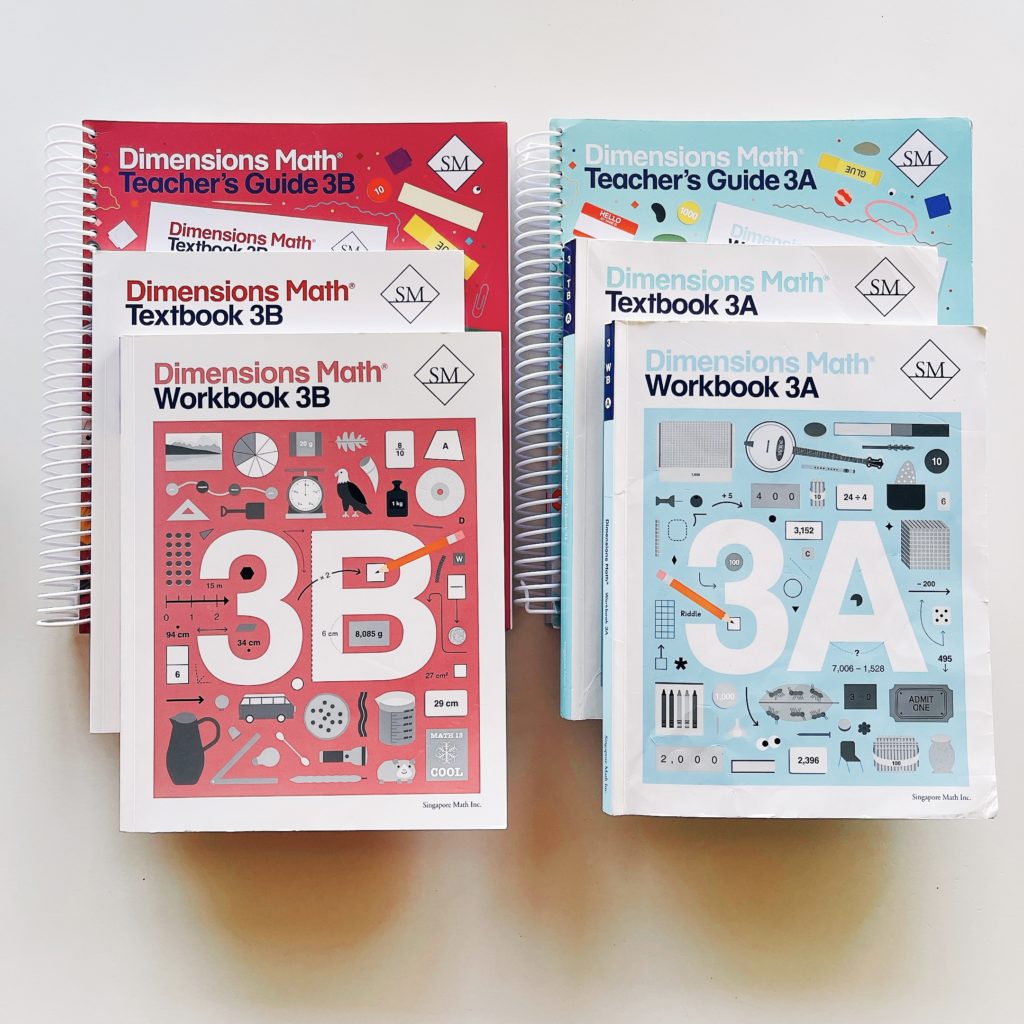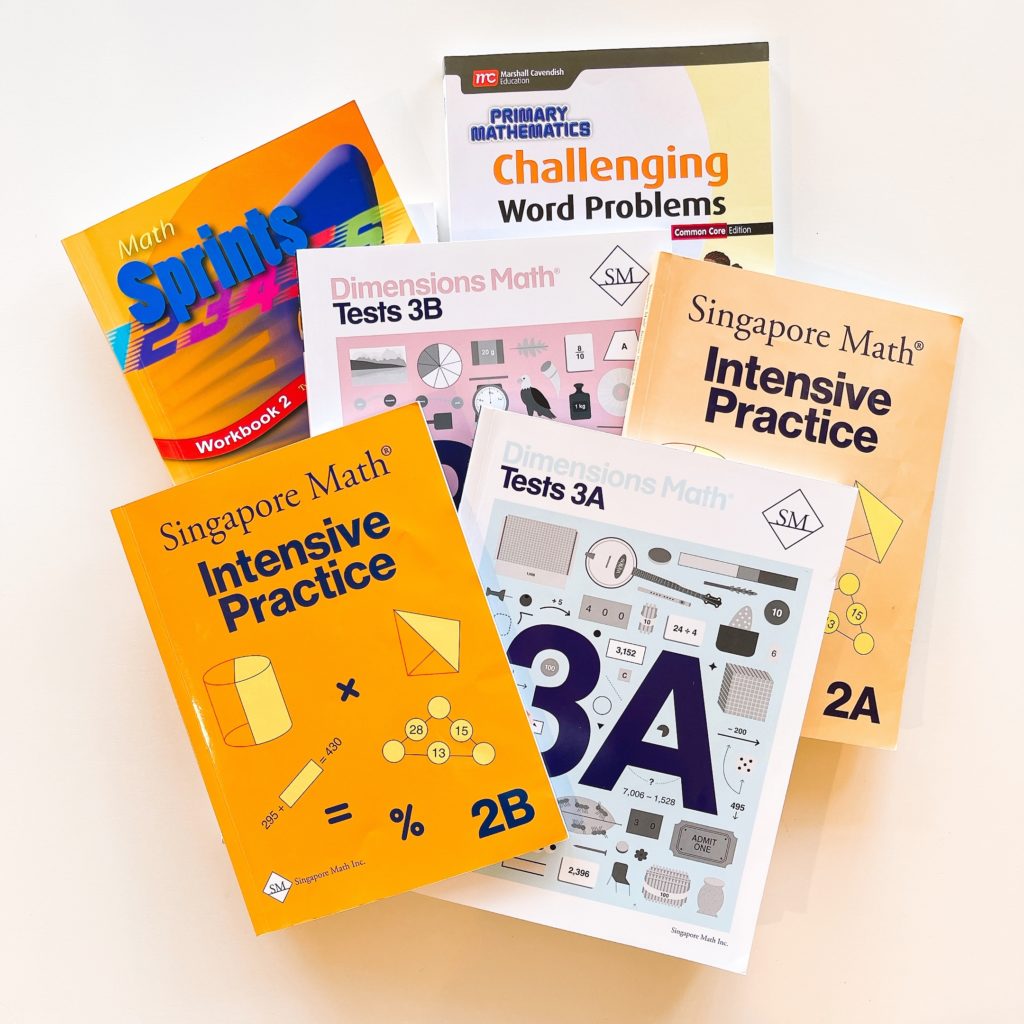math
homeschool math curriculum
Math is a core subject and will always be integral to your homeschool. Finding the right way to teach it is incredibly important. Some kids struggle with math while others breeze through it. Every child learns differently, and there are many curricula out there for you to try out. In our case, we use Singapore Math. It is the first program we committed to 100% and have not needed to switch it out. It is a mastery-based program, which means you will master a concept before moving to the next topic. They do not spiral back within a level, but there are many ways that you can gain added practice with their supplemental programs. Singapore Math has two programs – Dimensions Math and Primary Math. We use Dimensions Math.
You can read more about Singapore Math on their website.

A level in Singapore Math correlates to a full grade in school. If you are anything like our homeschool, your kid will likely move at a faster pace than at school and it is completely ok to move ahead to the next level at that time.
To teach one level you will need the following resources:
- Workbook A and B
- Textbook A and B
- Teacher’s Guide A and B.
(They now offer home instructor’s guides for a few levels which is essentially for the homeschool parent. It will include fewer activities and will not include classroom type activities)
Singapore Math offers so many supplemental resources that you will never have to supplement with another curriculum. As much as we love Singapore Math, if it is not a fit for your child —— don’t feel pressured to stick with it. Find what works for your child. That is key for learning and retention.
Extra Practice: This book offers additional practice at the same difficulty level as the Workbook.
Intensive Practice: The chapters are condensed and incrementally increase in difficulty. The bar models are drawn for the word problems, which was different from EP.
Challenging Word Problems: This book is full of word problems. I love this book because it shows you how to solve word problems before jumping into the exercise.
Sprints: These are timed math fact exercises with the intent to increase agility in computing and mental math.
Tests: There is Test A and B, which correlate with the workbook. Each chapter is tested, followed by a final test. I have a blog that gives you more detail about using the Test resources.

the key to learning math -manipulatives
Singapore Math does an excellent job of using concrete and pictorial methods to introduce math concepts. It is part of their CPA methodology (Concrete – Pictorial – Abstract).
We use a lot of manipulatives starting from our Montessori learning days. Your child will build foundational math concepts if they can touch it, feel it, count it, see it, and manipulate it. 1+1 in concept makes sense but your child needs to see it to understand how this operation comes to existence. It comes from taking two different groups (part) and bringing them together to make one group (whole).
Here’s a secret about using manipulative —— it is what makes math come to life. It is what makes it fun to learn. Use lego, magna-tiles, blocks, cars, or anything you have at home so that your kid will be excited to learn with you.
Manipulatives we use in our homeschool
Mathlink Cubes: This resource can be used for teaching early place values, build number sense, addition, subtraction, skip counting, etc.
Super Sorting Pie: I originally purchased this as a sensorial learning toy for my toddler but who knew that it would be used to teach many more things. You can teach sorting, colors, and counting. I use them in teaching how to understand word problems.
Fraction Cubes and Circles: You are going to need some manipulative for fractions and having both the cube and circle visual is very helpful.
Magnetic Ten-Frame: I use this a lot with my preschooler for all our K-level Singapore Math lessons. I highly recommend it.
Two-color counters: These are not required but very useful to have in teaching all operations. I used them recently to teach division and arrays – great visual learning method.
Portable White Board: This is what makes it possible to move homeschooling to any part of the home. We carry this whiteboard and use it extensively for math, spelling, etc.
100 Board: This is a Montessori tool used to teach your child to sequence numbers 1-100. It can be used to teach kids patterns, skip counting, addition, place value and many more things as long you get creative with it.
(Affiliate links included in this section)

Stamp Game: Since we are lovers of all things Montessori, I purchased this early on in our homeschool. It is used to teach all the mathematical operations. My oldest learned her basic math facts using this when in school.
math without curriculum?
A year ago, I taught my now 4.5 year old his numbers. I printed off a matching work from the Montessori Print Shop and I spent a few minutes every day teaching him to count and match that image with the correct number. I also had a math learning plan for my 6 year old at the time and we learnt all math operations, fractions, and geometry without curricula. It is completely possible but requires a lot of planning and effort upfront and is not sustainable in the long run.
Once you get to the Kindergarten level, I highly recommend considering a systematic math program so that your kid is building the foundational knowledge he/she needs for the higher levels.
